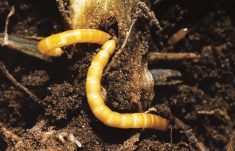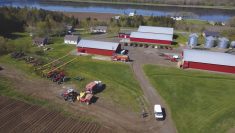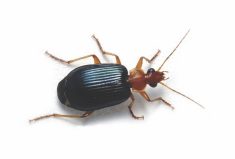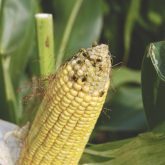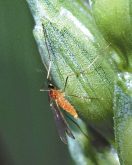What do shelterbelts, pivot corners and field margins have in common? No, they’re not unprofitable or “wasted” areas. As natural habitats for beneficial insects, including pollinators and predators of crop pests, those non-cropped areas may be worth their square footage in gold.
Alejandro Costamagna, an assistant professor in the University of Manitoba’s department of entomology, says those areas are a home for good bugs that can control the bad ones and save you money on insecticides.
Costamagna presented some of his research findings at the Manitoba Agronomists’ Conference last December, and he is at work on a publication looking at natural habitats near production areas in Manitoba.
Read Also

Agronomists share tips for evaluating new crop products and tech: Pt. 3
With new products, new production practices and new technology converging on the agriculture industry at a frenetic pace in recent…
“In annual cropping systems there is a portion of the year where beneficials have absolutely no cover, so it’s hard for them to survive in those environments,” he says.
When annual crops are harvested or senescing (starting to die), predators and pollinators have to look for resources elsewhere. For these insects, the presence of nearby natural or semi-natural habitats can mean life or death — and therefore a spot to reproduce for next season.
When it comes to particular crop pests such as soybean aphid, it also matters which crops are planted near soybean fields.
Costamagna’s study, conducted with his graduate student Ishan Samaranayake, looks at the effect of different crop types on soybean aphid populations and their control by natural predators such as lady beetles.
“What Ishan found was that the amount of cereals in the landscape was what best predicted soybean aphid control,” Costamagna says.

Cereals harbour lady beetles
Most cereals are not sprayed with insecticides, which means cereal acres allow both aphids and lady beetles to survive during the growing season. Aphids only become a problem for soybeans when cereal crops start to senesce and the insects have to look elsewhere for food. But if lady beetles have been given a fair chance, they will naturally keep aphid populations in check.
“We’re really interested in whether there are certain combinations of crops that provide better opportunities for beneficials to find resources throughout the year,” says Costamagna. “Having cereal crops in the area provides resources for predators, which provides benefits later on for soybeans.”
Costamagna hesitates to make many specific recommendations yet, due to the limited data from the study, but the goal of his research is to determine what good habitats should look like in order to help producers design landscapes that reduce pest problems. For example, how much uncultivated area is needed, and how close should it be to annual crops?
Already, however, Costamagna does say it’s clear that it’s good to leave as many uncultivated areas as possible (i.e. wooded areas, fencerows and field margins) to provide year-round habitats for beneficial insects.
“We only talk about pests when some of our activities disrupt beneficials in a way that they can no longer control them,” he says. “The natural pest control services that we have are pretty good, even in the harsh conditions we impose — spraying herbicides and tilling and harvesting. I’m hopeful that if we start giving beneficial insects better habitats, we can still see improvements.”
Protecting pollinators
Several Agriculture and Agri-Food Canada (AAFC) projects are underway in the Prairies, looking at the impacts of landscape features on pollinator habitats.
Laura Poppy, a researcher at AAFC’s Indian Head research station, is a partner on a new project looking at the diversity, role and structure of field boundary habitats, specifically non-cropped areas such as native hedgerows and planted shelterbelts. Researchers will record data on beneficial insects as well as microbes, birds, soil moisture, weeds, nutrients and yield.
After two years of data collection, the researchers will analyze the data from a bio-economic perspective to add up the economic and environmental benefits of these non-cropped areas for agricultural systems.

Poppy is also assisting a Manitoba-based project led by AAFC biologist Melanie Dubois, which aims to provide best management practices (BMPs) for habitat design and maintenance.
Over three years, Dubois will look at 36 sites owned by producer co-operators in western Manitoba, analyzing field usage by pollinators and recording species of native bees.
“If you go 400 metres into a quarter section, how many pollinators will you find there?” Dubois asks. “We’re expecting to see a decay rate — more pollinators closer to field margins than in the interior of the field. In areas with lots of cultivation and few natural areas, you’ll have reduced populations of native pollinators. That can be limiting when you’re growing crops like canola.”
Dubois’ tool for assessing habitats was developed by the U.S.-based Xerces Society. It looks at landscape features and the percentage of natural or semi-natural vegetation within a kilometre of the sampling site, as well as at the “farmscape” scale, within 500 metres of the sampling site.
“The magic number is about 30 per cent of natural cover to have a healthy, functioning pollinator population,” says Dubois.
The assessment tool also takes into account foraging habitat, or the percentage of pollinator-friendly trees and flowers in the area, plus nesting habitat and farm management practices.
Dubois aims to draft a list of recommendations within three years, and hopes land managers, conservation districts, NGOs and provincial organizations will initiate programs to help producers adopt pollinator BMPs.
She says protecting habitats is about “stacking benefits” — for pollinators, but also for the wider environment, as well as farm efficiency.
“We want people to look at their farms differently,” she says. “It’s not about taking areas out of production but asking how you can tweak them to provide habitats. There is a lot of flexibility.”
Dubois says there are promising new resources for producers interested in designing farm landscapes with pollinator habitat in mind. She points to a new $4 million dollar initiative led by Xerces and General Mills. It aims to plant up to 2,000 acres of pollinator habitat in Manitoba.
“They will plant native flowers, interseed legumes into pastures, plant flowering shelterbelts and annual flowering cover crops,” says Dubois. “They’ll pay for the seed and work with the producer on site establishment and technical support.”
Interested oat producers should contact Tom Rabaey at [email protected] or Jim Eckberg at [email protected] or call 1-651-491-8504 for more information.




